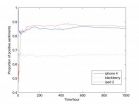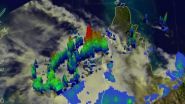(Press-News.org) VIDEO:
First Rowena and then Liza watch videos of familiar chimpanzees yawning.
Click here for more information.
In their latest study about empathy, Yerkes National Primate Research Center researchers Matthew Campbell, PhD, and Frans de Waal, PhD, have shown chimpanzees exhibit flexibility in their empathy, just as humans do. These findings, which appear in the current issue of the Proceedings of the Royal Society B, may help explain the evolution of how and when humans engage with others and choose to offer flexibility, and how we can do so more.
While it's been long known that human empathy can extend to family, friends, strangers and even other species, it has been unknown until now whether nonhumans are similarly broad in their empathic responses. To answer this question, Campbell and de Waal used contagious yawning as a measure of involuntary empathy. According to Campbell, "Copying the facial expressions of others helps us to adopt and understand their current state."
The researchers found chimpanzees showed contagious yawning to familiar chimpanzees, familiar humans, and unfamiliar humans, but not to unfamiliar chimpanzees or an unfamiliar species (gelada baboons). "That humans known and unknown elicited empathy similarly to group members, and more than unknown chimpanzees, shows flexibility in engagement," says Campbell. "We can use this information to try to influence this flexible response in order to increase empathy toward unfamiliar chimpanzees, and we hope we will be able to apply such knowledge to humans as well," Campbell continues.
This study is a follow up to a study published in 2009 that showed contagious yawning in chimpanzees is not just a marker of sleepiness or boredom, but that it is a sign of a social connection between individuals. Campbell and de Waal have continued their work to better understand empathy as a window into social and emotional connections between individuals in order to help break down barriers among humans.
INFORMATION:
This study was funded by the FIRST program, NIH/NIGMS (USA) IRACDA grant no. K12 GM000680, the National Center for Research Resources P51RR000165 and is currently supported by the Office of Research Infrastructure Programs/OD P51OD011132, and the Living Links Center at Yerkes.
For eight decades, the Yerkes National Primate Research Center, Emory University, has been dedicated to conducting essential basic science and translational research to advance scientific understanding and to improve the health and well-being of humans and nonhuman primates. Today, the center, as one of only eight National Institutes of Health–funded national primate research centers, provides leadership, training and resources to foster scientific creativity, collaboration and discoveries.
Yerkes-based research is grounded in scientific integrity, expert knowledge, respect for colleagues, an open exchange of ideas and compassionate quality animal care.
Within the fields of microbiology and immunology, neurologic diseases, neuropharmacology, behavioral, cognitive and developmental neuroscience, and psychiatric disorders, the center's research programs are seeking ways to: develop vaccines for infectious and noninfectious diseases; understand the basic neurobiology and genetics of social behavior and develop new treatment strategies for improving social functioning in autism and schizophrenia; interpret brain activity through imaging; increase understanding of progressive illnesses such as Alzheimer's and Parkinson's diseases; unlock the secrets of memory; treat drug addiction; determine how the interaction between genetics and society shape who we are; and advance knowledge about the evolutionary links between biology and behavior.
Empathy chimpanzees offer is key to understanding human engagement
2014-03-11
ELSE PRESS RELEASES FROM THIS DATE:
New gene for bipolar disorder discovered
2014-03-11
First on top of the world and then in the depths of despair – this is what the extreme mood changes for people with bipolar disorder are like. Under the direction of scientists from Bonn, Mannheim and Basel, an international collaboration of researchers discovered two new gene regions that are connected to the prevalent disease. In addition, they were able to confirm three additional suspect genes. In this unparalleled worldwide study, the scientists are utilizing unprecedented numbers of patients. The results are now being published in the renowned journal "Nature Communications."
Throughout ...
Dynamic stressing of a global system of faults results in rare seismic silence
2014-03-11
SAN FRANCISCO, March 11, 2014 -- In the global aftershock zone that followed the major April 2012 Indian Ocean earthquake, seismologists noticed an unusual pattern – a dynamic "stress shadow," or period of seismic silence when some faults near failure were temporarily rendered incapable of a large rupture.
The magnitude (M) 8.6 earthquake, a strike-slip event at intraoceanic tectonic plates, caused global seismic rates of M≥4.5 to spike for several days, even at distances tens of thousands of kilometers from the mainshock site. But beginning two weeks after the ...
Timid jumping spider uses ant as bodyguard
2014-03-11
A timid jumping spider uses the scent of ants as a secret weapon to save itself from becoming the somewhat soggy prey of the predatory spitting spider. The downside to this plan is that jumping spiders are also a favorite snack of its very own saviors. To overcome this additional hazard, the spider has made yet another plan in the form of an ant-proof nest, writes Ximena Nelson of the University of Canterbury in New Zealand and Robert Jackson of the University of Canterbury and the International Centre of Insect Physiology and Ecology in Kenya, in Springer's journal Behavioral ...
Magnet hospitals have higher quality of care, NYU researcher finds
2014-03-11
Magnet recognition is considered a leading source for measuring organizational success in nursing. Magnet hospitals show higher job satisfaction and lower odds of patient mortality than non-Magnet hospitals. However, only nine percent of American hospitals are recognized as Magnet. Currently, there is little research into the causes of the differences between Magnet and non-Magnet hospitals, research that could create an infrastructure for positive change in nurse and patient outcomes.
Now research from New York University College of Nursing (NYUCN) and the University ...
Some galaxies in the early universe grew up quickly
2014-03-11
Pasadena, CA— Some galaxies grew up in a hurry. Most of the galaxies that have been observed from the early days of the universe were young and actively forming stars. Now, an international team of astronomers, including Carnegie's Eric Persson and Andy Monson, have discovered galaxies that were already mature and massive in the early days. Fifteen mature galaxies were found at a record-breaking average distance of 12 billion light years, when the universe was just 1.6 billion years old. Their existence at such an early time raises new questions about what forced them to ...
Why antisocial youths are less able to take the perspective of others
2014-03-11
This news release is available in German. Adolescents with antisocial personality disorder inflict serious physical and psychological harm on both themselves and others. However, little is yet known about the underlying neural processes. Researchers at the University of Leiden and the Max Planck Institute for Human Development have pinpointed a possible explanation: Their brain regions responsible for social information processing and impulse control are less developed.
The study focused on incarcerated delinquent adolescents from the Netherlands aged between 15 and ...
How Twitter shapes public opinion
2014-03-11
WASHINGTON D.C., March 11, 2014 -- How exactly does Twitter, with its 241 million users tweeting out 500 million messages daily, shape public opinion?
That question was tackled by a group of researchers in China who investigated how opinions evolve on Twitter by gathering about 6 million 140-character-or-less messages that were tweeted out over a six month period in the first half of 2011. They ran these messages through computer algorithms that sorted them by topic ("iPhone 4" or "blackberry," for instance), and they analyzed the underlying sentiments of the authors ...
Soil microbes shift as shrubs invade remnant hill prairies
2014-03-11
URBANA, Ill. – Perched high on the bluffs of the big river valleys in the Midwest are some of the last remnants of never-farmed prairie grasslands. These patches, edged by forest, are slowly being taken over by shrubs. A recent University of Illinois study examined the soil microbes on nine patches, also called "balds," that had varying degrees of shrub invasion and found an interesting shift in the composition of the microbial community.
"When we looked at the soil samples from a lightly encroached hill prairie remnant, it was very clear that there was a set of fungi ...
Tracking neighborhood eating habits to promote healthier diets
2014-03-11
Poor food choices, such as overconsumption of carbonated soft drinks, are an important factor driving the global obesity epidemic and have been linked directly to diabetes and heart disease. While public health agencies are working to help people to make healthier choices, monitoring the effectiveness of these efforts has been costly and difficult. But now, using the same digital data employed by marketers to promote food products, McGill University's David Buckeridge has developed a way for health agencies to track Montreal consumers' food choices, neighborhood by neighborhood. ...
NASA saw some power in Tropical Cyclone Gillian before making landfall
2014-03-11
VIDEO:
The TRMM Satellite's Precipitation Radar data was used to create this 3-D flyby over Tropical Cyclone Gillian on March 10. Some powerful storms within Gillian reached heights above 16 km/~9.9...
Click here for more information.
NASA's TRMM satellite saw some towering thunderstorms in Tropical Cyclone Gillian before it made landfall over the Western Cape York Peninsula of Queensland, Australia. Gillian has been staying over land since, and is now a remnant low pressure area. ...



